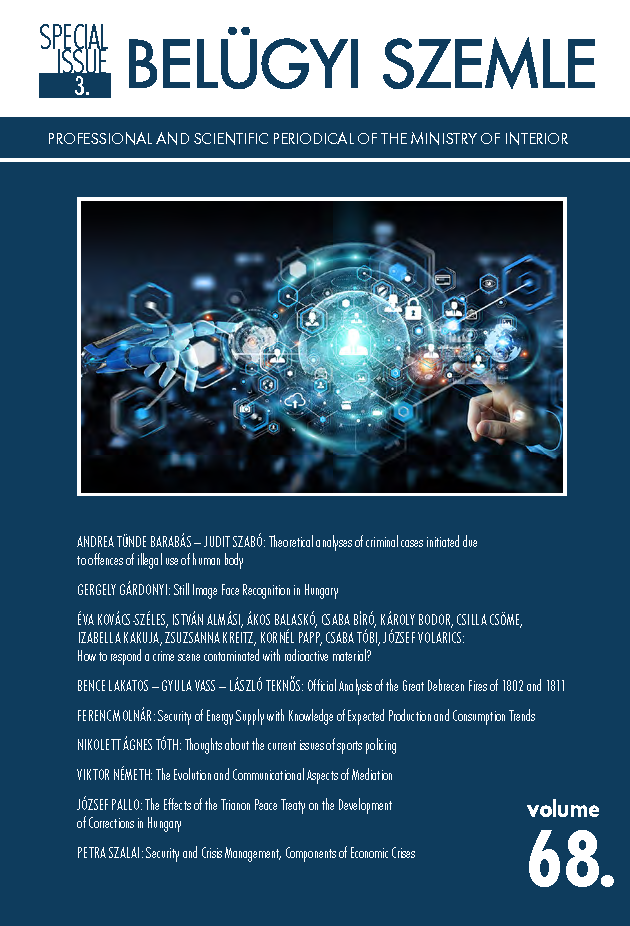Keywords
face recognition
analysis
biometric identification
expert
analysis
biometric identification
expert
How to Cite
Still Image Face Recognition in Hungary. (2020). Academic Journal of Internal Affairs, 68(3. ksz.), 22-33. https://doi.org/10.38146/BSZ.SPEC.2020.3.2
Abstract
The Still Image Facial Recognition System has been in operation for four years in Hungary. The present study details the experiences gained to date, as well as the possibilities, results and plans related to the subject. It briefly presents the history of still image face recognition, provides international outlook, describes the legal framework and the operation of the system, and finally outlines future development opportunities.
Downloads
Download data is not yet available.
Similar Articles
- Péter Ujhegyi, Arnold Őszi, The connection of biometric identification and AI, and its risk assessment possibilities , Academic Journal of Internal Affairs: Vol. 73 No. 5 (2025)
- Lászlóné Hazai, Questions of protection of automatic biometric identity verification systems - Presentation attacks, deception , Academic Journal of Internal Affairs: Vol. 73 No. 3 (2025)
- Lászlóné Hazai, Biometric identification , Academic Journal of Internal Affairs: Vol. 61 No. 5 (2013)
- Lászlóné Hazai, Methods, techniques in biometric facial recognition and identification , Academic Journal of Internal Affairs: Vol. 67 No. 1 (2019)
- Katalin Kondás, The identification of prisoners in the criminal justice system , Academic Journal of Internal Affairs: Vol. 71 No. 12 (2023)
- János Szabó, International framework for criminal analysis , Academic Journal of Internal Affairs: Vol. 71 No. 2 (2023)
- Péter Ujhegyi , Analysis of the spread of biometrics , Academic Journal of Internal Affairs: Vol. 71 No. 8 (2023)
- Csongor Herke, Tibor László Szécsi , The role of event data recorders (EDRs) in proving traffic offences , Academic Journal of Internal Affairs: Vol. 73 No. 4 (2025)
- Tamás Grósz, Caesar non supra grammaticos: can judges in criminal cases rule on experts’ opinion? , Academic Journal of Internal Affairs: Vol. 59 No. 6 (2011)
- András Czebe, Fuzzy logic behind forensic identity , Academic Journal of Internal Affairs: Vol. 68 No. 2. ksz. (2020): Special Issue
You may also start an advanced similarity search for this article.
Most read articles by the same author(s)
- Szabolcs Mátyás, Nikoletta Hablicsek, Gergely Gárdonyi, Innovative training opportunities for workers in operations management centers based on Polish experience , Academic Journal of Internal Affairs: Vol. 73 No. 1 (2025)
- Zsolt Pádár, Mónika Nogel, Gábor Kovács, Gergely Gárdonyi, Petra Zenke, Special Challenges of Wildlife Forensics in Hungary , Academic Journal of Internal Affairs: Vol. 71 No. 2.ksz. (2023): Special Issue
- Zsolt Pádár, Mónika Nogel, Gábor Kovács, Gergely Gárdonyi, Petra Zenke, Special Challenges of Wildlife Forensics in Hungary , Academic Journal of Internal Affairs: Vol. 70 No. 9 (2022)
- Gergely Gárdonyi, Still Image Face Recognition in Hungary , Academic Journal of Internal Affairs: Vol. 69 No. 7 (2021)
- Gergely Gárdonyi, Changes in the regulation of crime scene investigation in the new criminal procedure act , Academic Journal of Internal Affairs: Vol. 67 No. 12 (2019)
- Gergely Gárdonyi, Zoltán Hautzinger, The possible areas for improvement in researches in criminalistics , Academic Journal of Internal Affairs: Vol. 69 No. 10 (2021)
- Gergely Gárdonyi, Profiling at the scene of the crime – through the eyes of a professional , Academic Journal of Internal Affairs: Vol. 69 No. 12 (2021)
- Máté Metzger, Zsolt Újvári, Gergely Gárdonyi, Criminal application of photogrammetry: three-dimensional reconstruction of crime scenes, human corpses and objects , Academic Journal of Internal Affairs: Vol. 68 No. 11 (2020)
- Gergely Gárdonyi, Belügyi Szemle: a bold venture, the point of alignment, the community-building forum , Academic Journal of Internal Affairs: Vol. 70 No. 11 (2022)
- Gergely Gárdonyi, The limits of theoretical reconstruction , Academic Journal of Internal Affairs: Vol. 61 No. 10 (2013)

